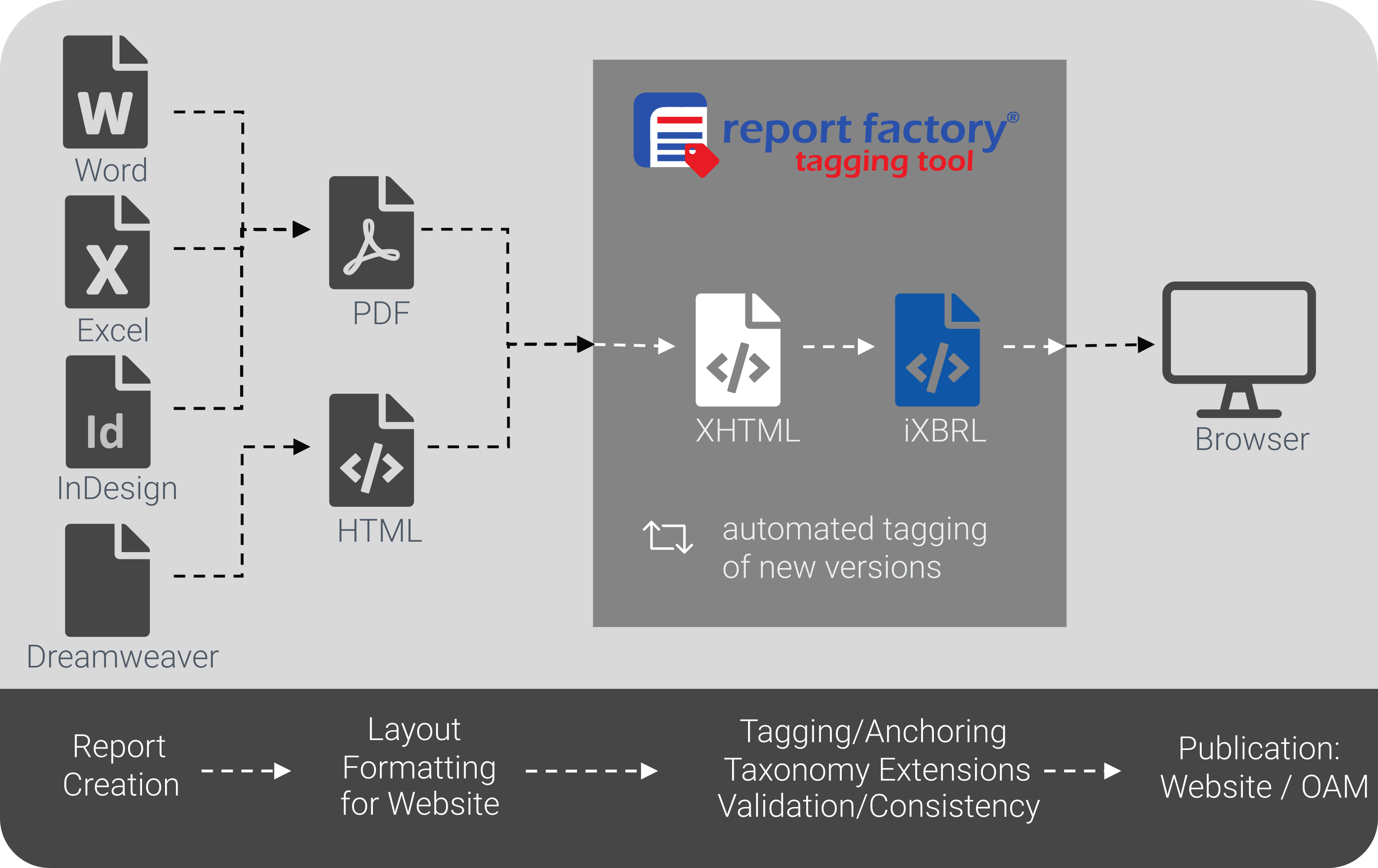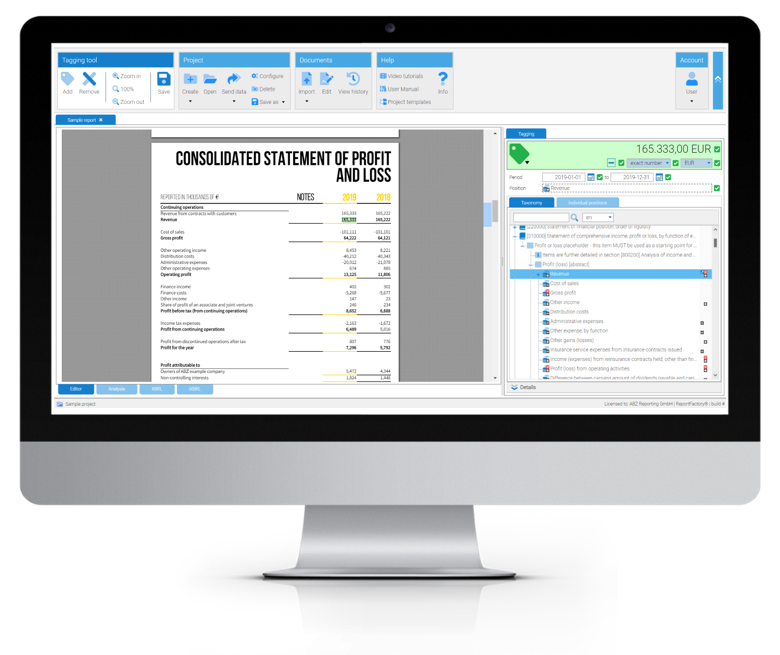OVERVIEW & FEATURES
The reportfactory© tagging tool allows for tagging of electronic financial reports in Inline XBRL (iXBRL) format.
The software provides functionality to extend existing report creation processes for paper and online reports towards digital reports. These digital reports can be analysed by software in an automated way, but they still provide professional human-readable layout.
tagging tool meets the requirements of ESMA according to the ESEF (European Single Electronic Format). For this purpose, it provides all required features like import of layout formats, tagging and anchoring, taxonomy extensions, as well as validation and consistency checks.
Besides financial statements according to IFRS, this covers sustainability reports as well according to ESRS (European Sustainability Reporting Standards) and Article 8 (EU taxonomy).
ESEF REQUIREMENTS / TARGET GROUPS



Hybrid formats advancing
With iXBRL ESMA has launched a hybrid format for company reports.
Hybrid formats can be read by humans and machines (software).
Before hybrid formats came into play, readability of electronic reports was problematic because they were displayed differently by varying software products.
The problem is solved by embedding of machine readably information (tags) in digital reports.
Consolidated IFRS statements have to be tagged and published in the machine readable format iXBRL. The reporting obligation aims at improved comparability and facilitates automated analysis.
In the future, sustainability reporting according to the ESRS taxonomy will also be carried out in this format.
The primary financial statements (statement of financial position, income statement, cash flow statement and statement of changes in equity.) and selected mandatory information in the Notes & Disclosures must be tagged in a machine-readable manner.
The ESEF filing rules are referred to as RTS (Regulatory Technical Standard). The rules have both business and technical background and need to be met by companies and software vendors.
Target groups for our software are in the first place companies with reporting obligations, besides that media agencies and auditors.
TOP 10 FEATURES AT A GLANCE
No process change/
Your reporting process may remain unchanged. Parallel to the existing process you can create tags and publish the tagged report together with its related print/PDF report.
Tagging/
Tagging is done intuitively by drag and drop. All of the taggin properties are prominent and visible. Properties can be modified for any number of selected tags at once.
Taxonomy extension/
Individual positions are required for almost every company report. Extensions to IFRS taxonomy are made easily without requiring obtaining technical skills.
Validity checks/
Due to the instant validation that occurs during tagging, errors are reported immediately preventing any follow-up issues. Naturally, all validations are done in an ESEF-compliant way.
Roll-forward/
For reports of subsequent years, all included tags are automatically rolled-forward. Only modified position names and new positions need to be (re)tagged.
Data import/
Input formats such as PDF and HTML are converted into iXBRL while preserving its layout and style. Referenced media files (e.g. images) are embedded.
Artificial Intelligence/
During the tagging you are supported by our AI (Artificial Intelligence) via smart proposals. This increases efficiency and avoids mistakes. All proposals can be accepted as is or adjusted manually.
Anchoring/
Anchoring of individual positions according to ESEF requirements is accomplished via mapping to positions from the IFRS taxonomy.
Report Package / Filing/
A report package is created for filing submission. All filing constituents (including taxonomy extension and related media) are assembled in a single package.
Word Add-In / Snippet/
Changes in report areas on MS Word level can be automatically updated at the tag level in the tagging tool.
USABILITY FIRST!
USABILITY is written in all caps in ReportFactory© software tools.
Imported company reports are displayed without any changes – they exactly the same as they are displayed on your website after publishing.
Even complex features are made simple in the intuitive graphical user interface. The modern design of menu ribbons was inspired by office applications.
Tagging is done quickly via drag and drop. All properties of a tag are displayed in a comprehensively designed calculator panel where they can be edited directly.
The IFRS taxonomy is illustrated in a compact and understandable way.
Calculation rules and links to drilldown sections are integrated into the taxonomy panel.
Along with instant validation this ensures an error-free creation of tagged reports.
Briefly
- WYSIWYG – What You See Is What You Get
- Intuitive user interface with ribbon toolbar
- Tag properties in calculator design
- Taxonomy view including calculation & drill-down
- Instant and ESEF-compliant validation markers
- Autotagging for new document versions
CERTIFIED SOFTWARE
When it comes to ESEF validity checks, lots of well-established but complex e-Reporting standards are used. That’s why conformance and quality are key issues. Related standards are developed and certified by XBRL International.
Both our creation software for electronic reports ReportFactory© as well as it’s integrated reporting engine ABRA TE are certified by XBRL International. The engine is integrated into many products of ABZ and our customers and is proven for reliable processing of large amount of data.
WHEN AND HOW TO TAG?
Process
You can create your consolidated financial statements in any common pre-format, which you then convert into PDF format.
When you import the PDF into our software, it is converted to XTHML/iXBRL and can then be tagged.
With the help of our Word Add-In (for local installation of MS Office Word 365), you can mark the areas for the block tags at Word level, which are then displayed in the tagging tool after import.
Financial information (table)
In the financial reports, tag properties can be applied to multiple tags in rows or columns using multi-selection. Calculation rules can also be edited. Due to the rounding tolerance, totals are also accepted by the auditors, even if they do not match the report 100%.
GCD
With our Detailed Tag function you can mark the GCD data for your company

Selection areas
In the selection area of our tags you can select various parameters, such as changing the sign, number range, decimal separator, currency, reporting period and taxonomy position.
Publishing is either done via sending a filing to the national OAM (Officially Appointed Mechanism) and/or at the website of an enterprise. For the latter the so called Report Package needs to be extracted.





